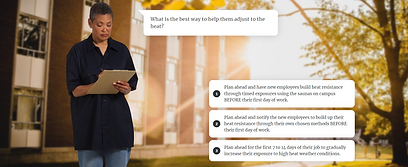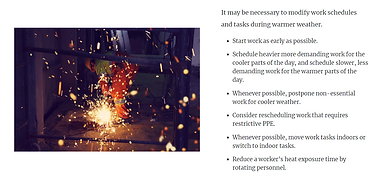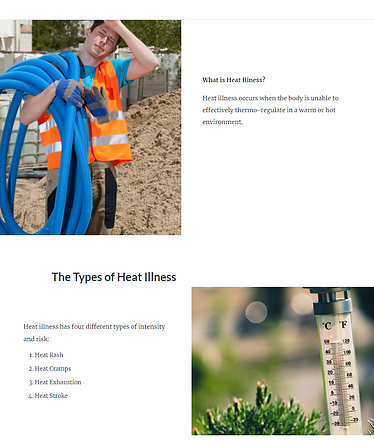Overview
Audience:
Supervisors managing teams working in high heat conditions
Responsibilities:
Instructional design, eLearning Development, Script Writing, Storyboarding, Voice Acting, Acting, Video Production, Photography.
Overview
Audience:
Supervisors and teams working in high heat conditions
Responsibilities:
Instructional design, eLearning Development, Script Writing, Storyboarding, Voice Acting, Acting, Video Production, Photography, Prototyping, SMEs & Stakeholder Facilitation.
Tools Used:
Articulate Storyline 360, Review 360, Rise 360, Adobe Lightroom.
Heat Illness is one of the highest ranked OSHA job safety violations. Large numbers of personnel are deployed and working in High Heat conditions almost daily.
After meeting with occupational health SMEs and other stakeholders, we confirmed that supervisors needed to be more proactive in providing drinking water, adequate shade, and scheduled cool down rests. Supervisors also needed practice in safely acclimatizing their personnel who may not be accustomed to working in High Heat.
I proposed an eLearning design that balanced OSHA compliance information with video, knowledge tests, and interactive learning scenarios where supervisors could practice making crucial Heat Illness Prevention decisions.
Our goal was to reduce heat illness incidents across the entire university via well informed and well practiced supervisors ready to respond to high heat conditions.


The Process: Compliance made uncomplicated
I was given a powerpoint deck from a pre-existing live classroom training. Knowing this format was inconvenient and unable to be distributed widely at a moments notice, I set out to convert this training into an asynchronous eLearning that was easy to access, practicle, and short.
The first step was to identify the actual business goals and behaviors that we wanted to see. After meeting with SMEs, we determined the goals and targeted behaviors. I suggested story based scenarios that simulate the decisions supervisors will have to make when high heat conditions arise.
After all SMEs approved the scenarios, I determined the minimum information needed to support each behavior. This was a negotiation process with SMEs who had a natural bias towards information overloading.
How much information do our learners actually need to know to do these behaviors? What information MUST be stated for compliance reasons? And most importantly, what jargon and parts of the original training could actually be cut or shortened and simplified? I planned to brake up long blocks of text to make them easier to read and support them with visuals.
From there, I wrote the entire word based script in Rise 360 with photos only as placeholders. This allowed SMEs to see early drafts of the training in Review 360 and make comments and edits on this first word based prototype. This also allowed for the team to see the entire outline of the eLearning, read through it, and have a concrete feel for the length and pace of the training.
After the word based script was approved, I moved into adding the visuals. Some of them I acquired from Articulate's library, others from stock, and others from my own photography and videography.
From there, I sent the final prototypes to upper management and other oversight committees for its final approval and publication.






